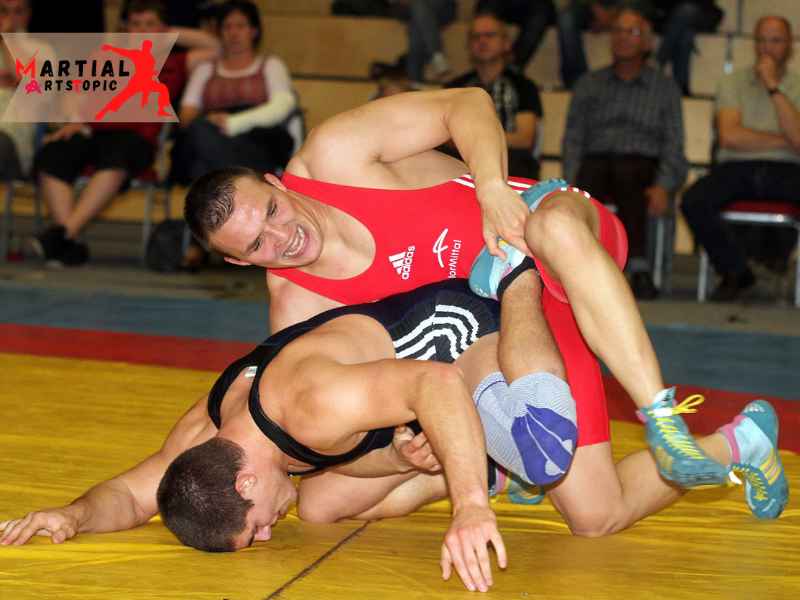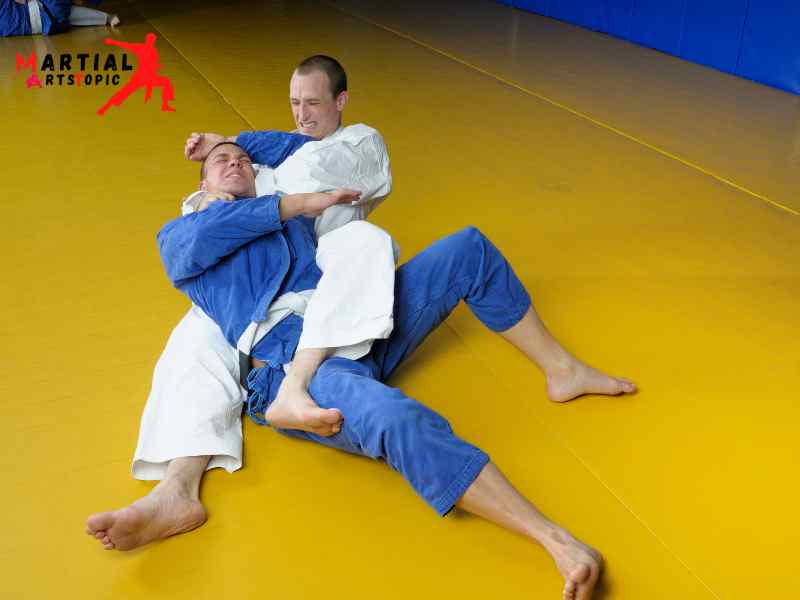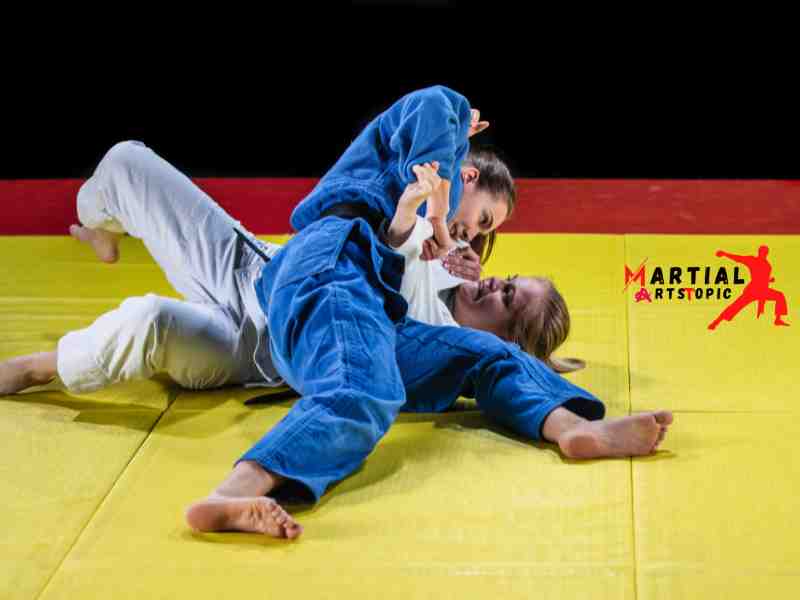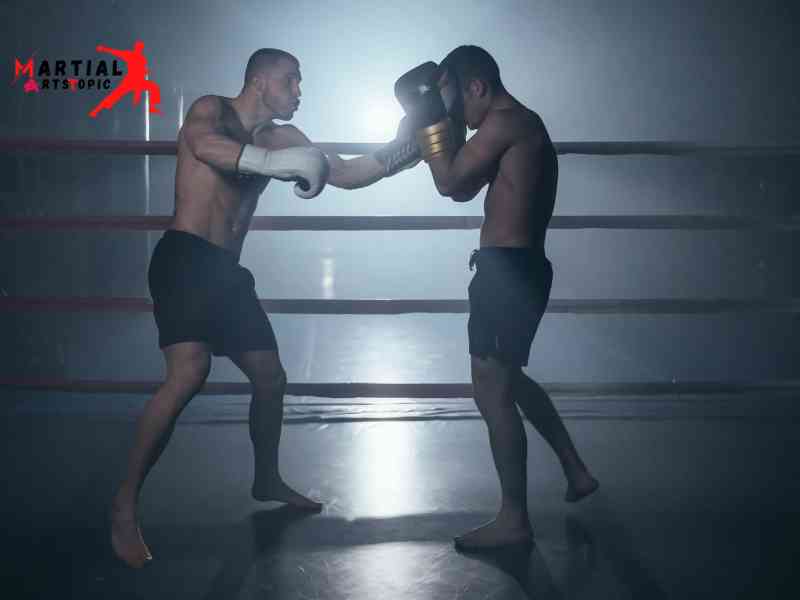
Fierce and Fearless: Unveiling the Ancient Martial Art of Pankration
What is Pankration? Unveil the ancient martial art of Pankration, a fearless and fierce discipline that has stood the test of time. Dating back to the ancient Olympic games, Pankration combines elements of wrestling and boxing, creating a formidable fighting style that emphasizes both physical strength and mental agility. This intense and demanding martial art requires practitioners to exhibit unwavering courage and determination, making it a true test of one’s inner strength and resolve. Embracing the spirit of Pankration means embracing fearlessness and pushing past one’s limits to achieve greatness. If you seek a martial art that embodies both history and raw power, Pankration may just be the perfect fit for you.
What is Pankration?
What is Pankration? Pankration, an ancient Greek martial art, is a blend of grappling and striking techniques. It was a crucial component of the ancient Olympics and is considered one of the earliest forms of mixed martial arts. The term “Pankration” itself means “all powers” or “all of power” in Greek, highlighting the comprehensive nature of the discipline. This combat sport allows the use of both striking and grappling techniques, making it a versatile and dynamic form of martial arts. The training and practice of Pankration emphasize physical conditioning, discipline, and mental fortitude. Today, Pankration continues to be practiced and admired for its historical significance and its effectiveness as a martial art.
Unveiling the History of Pankration: Ancient Greece’s Ultimate Combat Sport

Unveiling the History of Pankration: Ancient Greece’s Ultimate Combat Sport In the ancient world of Greece, there was a combat sport that stood above all others – Pankration. This unique and brutal form of martial arts captured the imagination of warriors and spectators alike, as it showcased the incredible physical prowess and skill of its participants. Today, we dive deep into the rich history of Pankration, exploring its origins, rules, and lasting legacy.
Pankration, derived from the Greek words “Pan” meaning “all” and “Kratos” meaning “strength,” was truly a sport that tested competitors in every aspect of combat. It combined elements of both boxing and wrestling, creating a dynamic and intense fighting style that had no boundaries. Participants in Pankration were allowed to strike, kick, and grapple, with the only two prohibited moves being eye-gouging and biting. Otherwise, anything was fair game.
The origins of Pankration can be traced back to the ancient Olympic Games in Greece. They believed it to have been introduced in 648 BCE, making it one of the oldest recorded combat sports. Pankration quickly gained popularity and became a staple of the Olympic Games, alongside disciplines such as wrestling and boxing. They even considered it one of the most prestigious events, showcasing the epitome of Greek athleticism.
The rules of Pankration were minimal, allowing for a raw and unfiltered display of strength, agility, and technique. Fighters aimed to incapacitate their opponents by any means necessary, using a combination of strikes, holds, and submissions. The fight would only come to an end when one of the fighters either submitted or was rendered unconscious.
What made Pankration truly unique was its lack of weight classes. They grouped participants solely based on age, with no consideration for size or weight. This resulted in matchups that pitted David against Goliath, creating an atmosphere of excitement and unpredictability. It was a genuine test of skill and determination, where the underdog often had a chance to shine.
The legacy of Pankration extends far beyond the ancient Greek world. Over the centuries, we can see its influence in various forms of combat sports and martial arts. The combination of striking and grappling techniques that defined Pankration laid the foundation for disciplines such as mixed martial arts (MMA) and Brazilian Jiu-Jitsu. Even today, these sports continue to captivate audiences worldwide, showcasing the same spirit of intensity and athleticism that Pankration once did.
As we delve into the history of Pankration, this ancient Greek combat sport was truly ahead of its time. It’s no-holds-barred approach to fighting and its emphasis on the all-around skills of its participants set it apart from other sports of its era. Pankration pushed the boundaries of physicality and endurance, serving as a testament to the indomitable spirit of the ancient Greeks.
Pankration: The Ultimate Martial Art for Self-Defense
Pankration: The Ultimate Martial Art for Self-Defense Are you searching for an incredibly effective martial art that can help you defend yourself in any situation? Look no further than Pankration, the ancient Greek combat sport that is making a comeback in the modern world. Pankration, also known as the ultimate martial art, combines elements of striking and grappling to create a devastatingly effective fighting style.
What is Pankration?
Pankration originated in ancient Greece and was a popular sport in the Olympic Games. It was a no-holds-barred fighting style that allowed competitors to use a combination of strikes, kicks, and grappling techniques. They considered pankration the ultimate test of physical strength, agility, and mental toughness.
Why is Pankration the Ultimate Martial Art for Self-Defense?
- Versatility: Pankration is unique in the sense that it encompasses both striking and grappling techniques. This versatility allows practitioners to adapt to any combat situation, whether it be standing or on the ground. No matter where the fight goes, a Pankration practitioner will be prepared.
- Realistic Self-Defense: Unlike many traditional martial arts that focus on stylized movements and forms, they designed Pankration for real-world self-defense situations. The techniques taught in Pankration are practical, efficient, and effective, making it an ideal martial art for those looking to protect themselves in a dangerous world.
- Full-Contact Training: Pankration is not for the faint of heart. Training in this martial art involves full-contact sparring and competition, allowing practitioners to develop their skills in realistic scenarios. This type of training builds mental toughness and prepares individuals for the stress and intensity of a real fight.
- Mental and Physical Fitness: Pankration is not just about learning how to fight; it is also a comprehensive fitness program. Training in Pankration improves cardiovascular endurance, strength, flexibility, and overall physical fitness. Additionally, the mental discipline required to excel in Pankration can enhance focus, concentration, and self-confidence.
- Historical Significance: Pankration has a rich history that stretches back thousands of years. By training in Pankration, practitioners are carrying on the legacy of ancient Greek warriors who were renowned for their martial prowess. There is a sense of honor and tradition that comes with practicing this ancient martial art.
How to Get Started in Pankration
If you’re ready to embark on the journey of learning Pankration, finding a reputable instructor or gym is crucial. Look for an experienced Pankration coach who can guide you through the intricacies of this martial art and ensure that you are learning proper techniques and safety protocols.
Pankration is the ultimate martial art for self-defense. Its versatility, realistic self-defense techniques, full-contact training, mental and physical fitness benefits, and rich historical significance make it a truly unique and powerful martial art. By training in Pankration, you will not only learn how to protect yourself, but also gain a deep appreciation for the ancient art of combat. So why wait? Start your Pankration journey today and unlock your true potential as a martial artist and self-defense practitioner.
Pankration: The Ultimate Test of Skill and Strength
Pankration: The Ultimate Test of Skill and Strength In the realm of combat sports, few are as ancient and awe-inspiring as Pankration. Dating back to the ancient Greeks, Pankration has stood the test of time as the ultimate test of skill and strength. Combining elements of wrestling and boxing, this intense martial art pushes its practitioners to their limits, both physically and mentally. In this blog post, we will delve into the world of Pankration, exploring its history, rules, and the qualities that make it such a remarkable discipline.
Origins of Pankration
Pankration can trace its roots back to ancient Greece, where it was a prominent feature of the original Olympic Games. Derived from the Greek words “pan” meaning “all” and “kratos” meaning “power,” Pankration truly lived up to its name. It was a no-holds-barred contest that allowed participants to use any means necessary to defeat their opponents. From punches and kicks to grappling and submissions, Pankration encompassed a wide range of techniques.
The Ultimate Test of Skill and Strength
Pankration was not just a display of brute force, but an accurate test of skill and strategy. Athletes had to possess a deep understanding of various martial arts techniques, as well as the ability to adapt to different situations. Speed, agility, and endurance were essential attributes for success in Pankration, as matches could last for hours without any breaks.
The Rules of Pankration
While Pankration was a fierce sport, it did have some rules in place to ensure the safety of the participants. Striking was allowed, including punches, kicks, and knee strikes. Grappling was also a fundamental aspect of Pankration, with competitors utilizing holds, throws, and submissions to gain an advantage. However, there were certain areas of the body that were off-limits, such as the eyes and genitals. Additionally, biting and gouging were strictly prohibited.
Qualities of a Pankration Athlete
To excel in Pankration, athletes needed to possess a unique set of qualities. Firstly, strength and power were vital, as they allowed competitors to deliver devastating strikes and overpower their opponents. Secondly, agility and flexibility played a crucial role, enabling athletes to evade attacks and execute complex grappling techniques. Mental fortitude was equally important, as Pankration demanded unwavering focus and the ability to remain calm under intense pressure.
Modern-Day Pankration
Although Pankration is no longer part of the Olympic Games, it has found a new home in the world of modern combat sports. Today, Pankration continues to captivate both athletes and spectators alike, with international competitions showcasing the incredible skills of its practitioners. We can see its influence in various mixed martial arts (MMA) events, where fighters draw upon the techniques and spirit of Pankration to achieve victory.
From Olympia to Modern Times: The Evolution of Pankration
From Olympia to Modern Times: The Evolution of Pankration Pankration, an ancient Greek martial art, has a rich and fascinating history that spans over centuries. This combat sport, which combines elements of boxing and wrestling, originated in the ancient Olympic Games and has strengthened significantly over time. In this blog post, we will explore the evolution of Pankration from its early roots in Olympia to its modern-day resurgence.
The Origins of Pankration in Olympia
Pankration was first introduced in the ancient Olympic Games in 648 BC, making it one of the oldest recorded combat sports in history. The word “Pankration” itself is derived from the Greek words “pan” meaning “all” and “kratos” meaning “strength.” True to its name, Pankration was a brutal and intense sport that required participants to use every part of their body to defeat their opponents.
In Olympia, Pankration was regarded as one of the most prestigious events of the Olympic Games. It was a test of both physical and mental strength, with participants often enduring grueling matches that pushed their limits. There were few rules in Pankration, allowing competitors to use a wide range of techniques, including punches, kicks, joint locks, and chokeholds.
The Evolution of Pankration

As the ancient Greek civilization flourished, so did the popularity of Pankration. It began to be practiced outside the Olympic Games, with schools and training centers dedicated to teaching the art of Pankration. These schools focused on refining techniques, developing strategies, and enhancing physical fitness.
Over time, they introduced certain rules and regulations to make Pankration safer for participants. Strikes to the groin and eyes were prohibited, and biting was strictly forbidden. Despite these limitations, Pankration remained a fierce and demanding sport that required immense skill and athleticism.
Pankration in Modern Times
After centuries of being lost to history, Pankration experienced a resurgence in the late 20th century. With the growing popularity of mixed martial arts (MMA), Pankration found a new audience and a new platform for showcasing its unique blend of striking and grappling techniques.
Today, they practiced Pankration worldwide, with organizations and competitions dedicated to preserving and promoting the sport. Modern Pankration combines elements of traditional Pankration with techniques from various martial arts disciplines such as Brazilian Jiu-Jitsu, Muay Thai, and boxing.
The sport has also undergone further rule modifications to ensure the safety of participants. Weight classes and protective equipment are now commonly used, and they implemented strict referee supervision during matches.
The Future of Pankration
As Pankration continues to gain traction in the world of combat sports, its future looks promising. Its roots in ancient Greek history and its dynamic nature make it a captivating sport that appeals to both athletes and spectators. With advancements in training methods and the constant evolution of combat sports, Pankration is likely to continue growing and adapting to modern times.
The Fascinating Training Regimen of Pankration Athletes
The Fascinating Training Regimen of Pankration Athletes Pankration, an ancient Greek combat sport, is a discipline that combines elements of both boxing and wrestling. The training regimen of Pankration athletes is not only physically demanding but also mentally challenging. In this blog post, we will explore the fascinating training methods employed by Pankration athletes, highlighting the key aspects that contribute to their success in the sport.
Strength and Conditioning
Pankration athletes undergo rigorous strength and conditioning training to develop explosive power, endurance, and flexibility. This includes weightlifting, bodyweight exercises, plyometrics, and cardiovascular workouts. These exercises help build a solid foundation for the intense physical demands of Pankration, allowing athletes to deliver powerful strikes and execute grappling techniques with precision.
Striking Techniques
Pankration athletes focus on developing effective striking techniques, including punches, kicks, and knee strikes. Training sessions involve practicing various striking combinations, honing accuracy, speed, and timing. Pankration fighters also learn to strike from different angles and distances, ensuring they are well-prepared for any situation that arises during a fight.
Grappling and Submission Techniques
Grappling is a fundamental aspect of Pankration. Athletes spend countless hours practicing takedowns, throws, and submission holds. This includes learning techniques such as joint locks, chokes, and holds that can immobilize opponents. Pankration athletes study both offensive and defensive grappling techniques to maintain control and to effectively counter their opponents’ moves.
Cardiovascular Endurance
Pankration matches can be physically grueling, often lasting several rounds. Athletes must have exceptional cardiovascular endurance to maintain their stamina throughout the bout. To achieve this, Pankration fighters engage in high-intensity interval training (HIIT), long-distance running, and other cardiovascular exercises to improve their overall endurance and recovery.
Mental Toughness
Pankration training goes beyond physical conditioning; it also emphasizes mental fortitude. Athletes are trained to stay focused, composed, and adaptable in the face of intense pressure. Mental exercises, such as visualization and meditation, are incorporated into training sessions to enhance concentration, mental clarity, and decision-making skills during fights.
Sparring and Competition
Regular sparring sessions are an integral part of a Pankration athlete’s training regimen. These sessions allow athletes to apply their techniques in a controlled environment, helping them refine their skills and develop strategic thinking. Competing in both amateur and professional fights is also crucial for Pankration athletes to gain experience, test their abilities, and continually improve their performance.
The Evolution of Pankration: From Ancient Greece to Modern MMA
The Evolution of Pankration: From Ancient Greece to Modern MMA Pankration, an ancient Greek combat sport, holds a significant place in the history of martial arts. With its raw intensity and no-holds-barred approach, it laid the foundation for what we now know as modern mixed martial arts (MMA). In this blog post, we will delve into the fascinating journey of Pankration, tracing its roots back to ancient Greece and exploring how it has developed into the thriving sport we see today.

Originating in the early Olympic Games, Pankration was a combination of various martial arts disciplines, including wrestling and striking. It was an accurate test of physical strength, agility, and technique. In fact, they often referred Pankration to as the world’s oldest recorded martial art, with its origins dating back to the 7th century BCE.
The word “Pankration” itself is derived from the Greek words “pan” meaning “all” and “kratos” meaning “strength.” This perfectly encapsulates the essence of the sport, which allowed competitors to utilize a wide range of techniques, including punches, kicks, takedowns, and submissions. However, certain moves, such as eye gouging and biting, were strictly prohibited – a rule that still holds true in modern MMA.
During its early days, Pankration gained immense popularity in ancient Greece, becoming one of the most highly regarded sports in the Olympic Games. It was seen as a true test of a warrior’s skills and bravery. Competitors would enter the arena clad in only a loincloth, ready to engage in intense combat until one emerged victorious.
The rules of Pankration were minimal, allowing fighters to use any means necessary to defeat their opponents. Unlike other ancient combat sports, such as boxing and wrestling, Pankration did not limit the techniques that could be employed. This made it a truly versatile and unpredictable sport, setting it apart from its contemporaries.
As time went on, however, Pankration faced some challenges. With the decline of the ancient Greek civilization, the sport began to lose its prominence and eventually disappeared altogether. It wasn’t until the late 19th century that Pankration resurfaced, albeit in a distinct form.
In the 1890s, a Frenchman named Georges Hébert developed a new combat sport called “La Boxe Française Savate.” Combining elements of boxing and kicking, this sport drew inspiration from Pankration and set the stage for the evolution of modern MMA.
Fast forward to the 1990s, when the Ultimate Fighting Championship (UFC) burst onto the scene, revolutionizing combat sports forever. What started as a tournament to determine the most effective martial art quickly developed into a showcase of diverse skills, much like the ancient Pankration.
MMA fighters began to adopt techniques from various martial arts disciplines, including Brazilian Jiu-Jitsu, Muay Thai, wrestling, and boxing. This cross-training approach allowed fighters to become well-rounded athletes, capable of both striking and grappling, just as the ancient Pankration fighters were.
Today, MMA has become a global phenomenon, with organizations like the UFC and Bellator showcasing some of the world’s most skilled fighters. The sport continues to strengthen, with new techniques and strategies being developed and refined.
So, the next time you step inside the octagon or watch a thrilling MMA fight, remember the ancient warriors who laid the foundation for this incredible sport. Pankration may have strengthened, but its essence remains unchanged–the pursuit of strength, skill, and the ultimate test of a fighter’s heart.
Mastering Pankration: Essential Techniques and Training Tips
Mastering Pankration: Essential Techniques and Training Tips Are you ready to take your combat skills to the next level? Look no further than Pankration, an ancient Greek martial art that combines the best elements of boxing and wrestling. In this comprehensive guide, we will delve into the essential techniques and training tips to help you master the art of Pankration.
Pankration, also known as “all-power” or “all-force,” is a combat sport that dates back to ancient Greece. It was considered one of the toughest and most brutal forms of martial arts, emphasizing the use of both striking and grappling techniques. Today, Pankration has gained popularity as a competitive sport and an effective self-defense system.
To truly excel in Pankration, it is crucial to develop a solid foundation in striking and grappling. Let’s inspect some essential techniques that every Pankration practitioner should master:
Striking Techniques:
- Punches: Learn the basic punches, including jabs, hooks, and uppercuts. Focus on accuracy, speed, and timing.
- Kicks: Master various kicking techniques, such as front kicks, roundhouse kicks, and side kicks. Practice proper footwork and balance.
- Elbows and Knees: Incorporate elbow strikes and knee strikes into your arsenal. These can be devastating close-range weapons.
Grappling Techniques:
- Throws and Takedowns: Study different throws and takedowns to gain control over your opponent. Focus on leverage and timing to execute them effectively.
- Joint Locks: Learn how to apply joint locks, such as arm bars and leg locks, to immobilize or submit your opponent.
- Chokes and Strangles: Explore various chokeholds and strangles to cut off your opponent’s air supply or blood circulation.
In addition to mastering these techniques, proper training is essential to excel in Pankration. Here are some training tips to enhance your skills:
Strength and Conditioning:
- Incorporate strength training exercises, such as weightlifting and bodyweight exercises, to build overall strength and power.
- Include cardiovascular exercises, like running or swimming, to improve endurance and stamina.
Flexibility and Mobility:
- Regularly stretch your muscles to improve flexibility and prevent injuries. Focus on stretches that target the areas used in Pankration, such as hips, shoulders, and legs.
- Practice yoga or Pilates to enhance flexibility and core strength.
Sparring and Drills:
- Engage in regular sparring sessions with partners of varying skill levels. This will sharpen your technique, timing, and adaptability.
- Drill specific techniques repeatedly to improve muscle memory and reaction time.
Mental Preparation:
- Develop mental toughness and focus through meditation or visualization exercises.
- Stay calm and composed during training and competitions, as Pankration requires quick thinking and strategizing.
Remember, mastering Pankration takes time, dedication, and consistent practice. Always prioritize safety and train under the guidance of a qualified instructor. Whether you aspire to compete or simply want to improve your self-defense skills, Pankration offers a dynamic and challenging path to personal growth.
Conclusion
Pankration is not just a sport, but a powerful testament to the strength, skill, and discipline of its participants. With its ancient origins and rich history, Pankration has stood the test of time, developing and captivating audiences throughout the centuries. Its blend of striking and grappling techniques makes it a unique and dynamic martial art that requires both physical and mental fortitude. Whether practiced as a competitive sport or as a means of self-defense, Pankration has proven to be a powerful platform for athletes to showcase their abilities and push the boundaries of human potential. As we look to the future, it is certain that Pankration will continue to inspire and enthrall generations to come.
